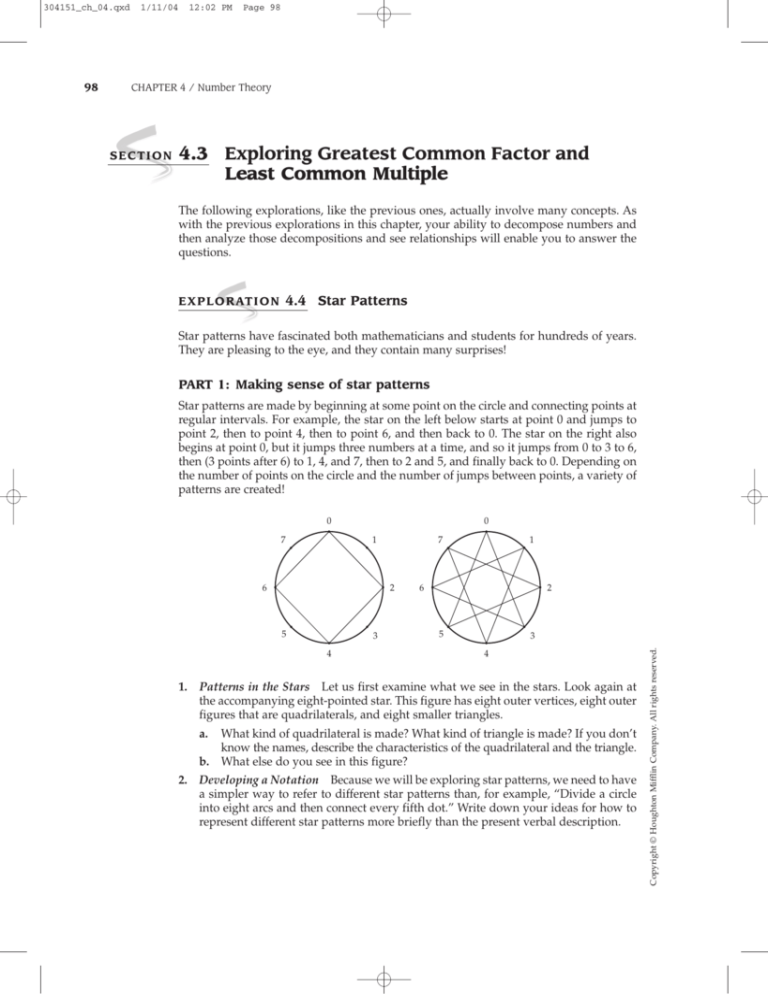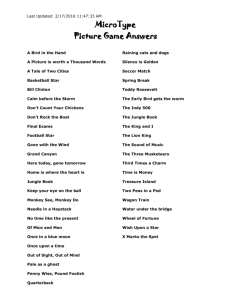
304151_ch_04.qxd
12:02 PM
Page 98
CHAPTER 4 / Number Theory
SECTION
4.3 Exploring Greatest Common Factor and
Least Common Multiple
The following explorations, like the previous ones, actually involve many concepts. As
with the previous explorations in this chapter, your ability to decompose numbers and
then analyze those decompositions and see relationships will enable you to answer the
questions.
E X P L O R AT I O N 4.4
Star Patterns
Star patterns have fascinated both mathematicians and students for hundreds of years.
They are pleasing to the eye, and they contain many surprises!
PART 1: Making sense of star patterns
Star patterns are made by beginning at some point on the circle and connecting points at
regular intervals. For example, the star on the left below starts at point 0 and jumps to
point 2, then to point 4, then to point 6, and then back to 0. The star on the right also
begins at point 0, but it jumps three numbers at a time, and so it jumps from 0 to 3 to 6,
then (3 points after 6) to 1, 4, and 7, then to 2 and 5, and finally back to 0. Depending on
the number of points on the circle and the number of jumps between points, a variety of
patterns are created!
0
7
0
1
6
2
5
3
4
1.
7
1
6
2
5
3
4
Patterns in the Stars Let us first examine what we see in the stars. Look again at
the accompanying eight-pointed star. This figure has eight outer vertices, eight outer
figures that are quadrilaterals, and eight smaller triangles.
What kind of quadrilateral is made? What kind of triangle is made? If you don’t
know the names, describe the characteristics of the quadrilateral and the triangle.
b. What else do you see in this figure?
a.
2.
Developing a Notation Because we will be exploring star patterns, we need to have
a simpler way to refer to different star patterns than, for example, “Divide a circle
into eight arcs and then connect every fifth dot.” Write down your ideas for how to
represent different star patterns more briefly than the present verbal description.
Copyright © Houghton Mifflin Company. All rights reserved.
98
1/11/04
304151_ch_04.qxd
1/11/04
12:02 PM
Page 99
Section 4.3 / Exploring Greatest Common Factor and Least Common Multiple
3.
99
Initial Hypothesis Look again at the star patterns on p. 98. We will refer to the star
pattern on the left on page 98 as star (8, 2) and to the pattern on the right as star (8, 3).
This notation for describing star patterns uses the ordered-pair idea developed in
Chapter 2: The first number tells us how many equal arcs the circle has been divided into, and the second number tells us the rule for connecting dots. However, other
notations for naming star patterns are possible, such as S82 and S83 ; that is, this way of
naming star patterns is a convention.
Now let us focus on the relationships between these two numbers. We found
that star pattern (8, 2) is a square and star pattern (8, 3) is an eight-pointed star. The
question that we will now explore is: Just from looking at the two numbers in any
star pattern x, n, can you predict what the star pattern will look like?
Brainstorm with your group how you might explore this question. What strategies seem more reasonable or potentially productive? Below are seven circles that
you can trace and then see what patterns emerge when you use different values for
x and n. After brainstorming and preliminary exploration, answer the following
questions.
Describe the strategies that you chose to employ, and briefly explain your reasons for choosing those strategies.
b. Describe your observations, the questions that occurred to you, and any preliminary hypotheses you formed on the basis of your initial explorations. Explain
why you think your hypotheses are true.
Copyright © Houghton Mifflin Company. All rights reserved.
a.
100
1/11/04
12:02 PM
Page 100
CHAPTER 4 / Number Theory
PART 2: From observations to hypotheses to
generalizations
Exploring One Star Family
In exploring a phenomenon, if often helps to be systematic. In this case, we will systematically examine all members of the 8, n star family— that is, all seven star patterns that
can be made by dividing a circle into eight arcs.
1.
Make the stars in the 8, n star family and record your thinking and your work
according to the following directions. First predict what you think the star will look
like. If your prediction was correct, move on. If it was not, explain why your prediction was not accurate, or explain what you learned by drawing the star.
2.
After making all of the patterns, do the following:
Describe and explain any observations that you made. For example, stars (8, 3)
and (8, 5) are the same. Can you explain why?
b. State any hypotheses you have about star patterns in general. For example, can
you make a prediction about what happens when the second number does or
does not divide the first number evenly?
c. Note any questions that you have.
a.
Exploring Another Star Family
3.
Make the stars in the 7, n star family. As before, first predict next what you think
you will find, next make the pattern, and then reflect on your prediction if it was not
correct.
4.
After making all the patterns, do the following:
a.
b.
c.
Describe and explain any observations that you made.
State any hypotheses you have about star patterns in general.
Note any questions that you have.
5.
Use the sheets on pages 101– 103 to explore other star families. Look for patterns
within and between families. Summarize any generalizations that you can make and
your justification of those generalizations. For example, if x is prime, then. . . .
6.
When making star patterns, you found that some of the stars were equal; for example,
star 8, 3 star 8, 5. Can you jump from this observation to a more general
hypothesis? For example, when will star x, a star x, b?
7.
There are other instances in which two star patterns will be equal. For example, draw
the 12, n star family and the 6, n family if you have not yet done so. Is it possible
that there are numbers a and b such that star 12, a star 6, b? Can you state your
observations as one or more hypotheses?
8.
What other hypotheses have you come up with? State your hypotheses and explain
why you think they are true.
9.
The following questions that are often raised by students deal with the ideas of limitations on x and n. Answer these questions.
a. Is it possible to have star x, x? If so, what would it look like? If not, why not?
b. Is it possible to have star x, 0? If so, what would it look like? If not, why not?
c. Is it possible to have star x, 1? If so, what would it look like? If not, why not?
Copyright © Houghton Mifflin Company. All rights reserved.
304151_ch_04.qxd
304151_ch_04.qxd
1/11/04
12:02 PM
Page 101
Section 4.3 / Exploring Greatest Common Factor and Least Common Multiple
101
Star Families for E X P L O R AT I O N 4.4 PART 2, Steps 1 and 3
1.
Copyright © Houghton Mifflin Company. All rights reserved.
3.
8, n star family
Star (8, 1)
Star (8, 2)
Star (8, 3)
Star (8, 5)
Star (8, 6)
Star (8, 7)
Star (8, 4)
7, n star family
Star (7, 1)
Star (7, 2)
Star (7, 3)
Star (7, 4)
Star (7, 5)
Star (7, 6)
304151_ch_04.qxd
1/11/04
12:02 PM
Page 103
Section 4.3 / Exploring Greatest Common Factor and Least Common Multiple
Star Families for E X P L O R AT I O N 4.4 PART 2, Step 5
6, n star family
Star (6, 3)
Star (6, 2)
Star (6, 1)
9, n star family
Star (9, 4)
Star (9, 3)
Star (9, 2)
Star (9, 1)
Copyright © Houghton Mifflin Company. All rights reserved.
10, n star family
Star (10, 1)
Star (10, 2)
Star (10, 4)
Star (10, 5)
Star (10, 3)
103
304151_ch_04.qxd
1/11/04
12:02 PM
Page 105
Section 4.3 / Exploring Greatest Common Factor and Least Common Multiple
Star Families for E X P L O R AT I O N 4.4 PART 2, Step 5
11, n star family
Star (11, 1)
Star (11, 2)
Star (11, 4)
Star (11, 5)
Star (11, 3)
Copyright © Houghton Mifflin Company. All rights reserved.
12, n star family
Star (12, 1)
Star (12, 2)
Star (12, 3)
Star (12, 4)
Star (12, 5)
Star (12, 6)
105








